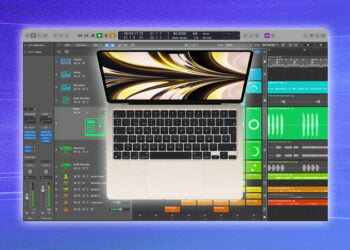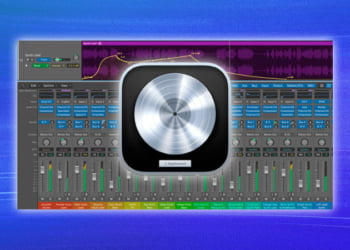For many music producers, ensuring a track has a clean, crisp sound is essential for creating professional music.
One of the most common issues producers experience is background noise, which can significantly detract from the overall quality of a track.
Thankfully, Logic Pro X offers users a range of tools to help remove unwanted noise from their project.
In this blog post, we’ll be exploring how to use Logic Pro X to battle noise interference, so you can produce better quality audio.
We’ll be discussing techniques and tools to help you reduce noise, as well as tips and tricks to help you achieve the perfect sound.
So if you’re looking to clean up and refine the quality of your audio, be sure to read on and discover how to remove noise in Logic Pro X!
Utilize the Noise Gate Plugin
One of the most effective ways to remove noise from a Logic Pro X recording is to utilize the Noise Gate plugin.
This plugin is designed to reduce unwanted background noise and hum from a recording, allowing for a more professional sounding mix.
To use the Noise Gate plugin, begin by setting the threshold to the level of background noise you wish to reduce.
Then, adjust the attack and release settings to determine the length of time it takes for the plugin to kick in and cut off the noise.
Finally, adjust the gain to the desired level and make any other adjustments to the plugin settings as needed.
With a few simple adjustments, you can easily reduce noise from any recording in Logic Pro X.
Adjust the Threshold, Attack, and Release parameters
The next step in the noise removal process is to adjust the threshold, attack and release parameters.
The goal of this adjustment is to identify the threshold at which noise should be removed, how quickly the noise should be reduced, and how fast the sound should return to its original level.
To do this, you’ll need to adjust the Threshold, Attack and Release parameters.
Start by setting the Threshold to the point where the signal is just below the background noise, then adjust the Attack and Release parameters until the desired amount of noise has been removed.
Utilize the De-Esser Plugin
When it comes to removing noise from an audio track, the De-esser plugin is an invaluable piece of software in Logic Pro X.
This plugin allows you to reduce or eliminate sibilance in a vocal track, making it sound more professional and polished.
To use the De-Esser plugin, first select the desired track and then click the “Plug-Ins” button.
In the Plug-ins window, select “De-Esser” from the list of available plugins. From there, you can adjust the intensity, frequency range, and other parameters to achieve the desired effect.
With a few tweaks, you can easily reduce or eliminate sibilance in a vocal track, allowing you to create a cleaner, more professional sound.
Adjust the Sensitivity and Frequency parameters
Once you have selected the type of noise you want to remove, you can adjust the Sensitivity and Frequency parameters accordingly.
The Sensitivity parameter determines how aggressive the noise gate will be at removing the unwanted noise.
The Frequency parameter sets the frequency range where the noise should be removed.
When setting these parameters, be sure to use your best judgment and adjust them as needed.
Keep in mind, the higher the Sensitivity and Frequency parameters, the more the noise will be removed.
Use the Adaptive Mode in the Denoiser Plugin
The Adaptive Mode in the Denoiser plugin is an effective way to remove noise from your audio track in Logic Pro X.
The Adaptive Mode uses a combination of noise reduction and frequency-adaptive filtering to target and reduce specific frequencies in your audio track.
To use the Adaptive Mode, first select the Denoiser plugin from the Audio Effects window in Logic Pro X.
Then, adjust the settings to apply the desired degree of noise reduction and frequency filtering, and click the Adaptive option to activate the Adaptive Mode.
After adjusting the settings, click the Preview button to listen to the effect the Adaptive Mode has on your audio track.
When you are satisfied with the results, click the Apply button to apply the Denoiser settings.
Adjust the Reduction and Speed parameters
Once you’ve selected the noise print and applied the noise gate, it’s time to adjust the Reduction and Speed parameters.
The Reduction parameter determines the amount of noise reduction applied to the signal and is measured in decibels (dB).
The Speed parameter determines how quickly the noise gate opens and closes and is measured in milliseconds (ms).
It is important to adjust these parameters to achieve the desired level of noise reduction without compromising the quality of the audio signal.
Experiment with different settings and use your ears to determine the best combination of Reduction and Speed.
Utilize the Ambience Plugin
The seventh step in removing noise in Logic Pro X is to utilize the Ambience plugin.
This plugin is designed to help reduce background noise and room ambience, while also simulating the effect of different acoustic environments.
It works by analyzing the sound of the original source and creating an opposing soundwave to cancel out the noise.
To use the Ambience plugin, simply drag it onto your track and adjust the parameters accordingly.
It’s an easy and effective way to remove noise and achieve a professional sound.
Adjust the Decay and Character parameters
After identifying the noise in your Logic Pro X project, the next step is to adjust the Decay and Character parameters to effectively remove it.
The Decay parameter sets how long the noise reduction process will take to reduce the noise; the higher the number, the longer it will take.
The Character parameter determines how much of the sound you want to remove, on a scale from 0-100.
If you set it too low, it could lead to audible artifacts in the signal; if you set it too high, it could cause a loss of audio quality.
Adjust these parameters until you have the desired result.
Conclusion
In conclusion, removing noise from your audio recordings in Logic Pro X is not a difficult process.
By using the Noise Gate, EQ, and Compressor tools, you can easily reduce noise from your recordings and make them sound much better.
This technique can be used on any kind of audio, from vocals to instruments, and will allow you to produce the highest quality recordings possible.






















